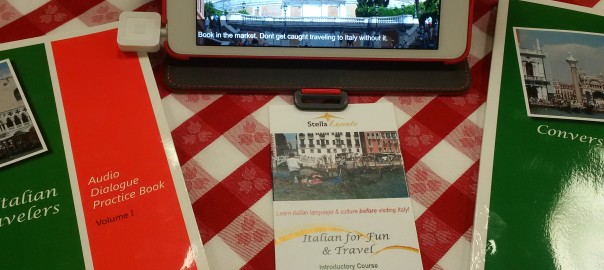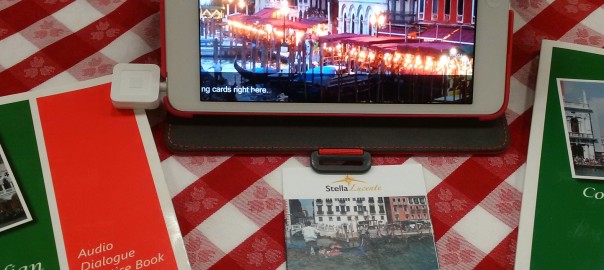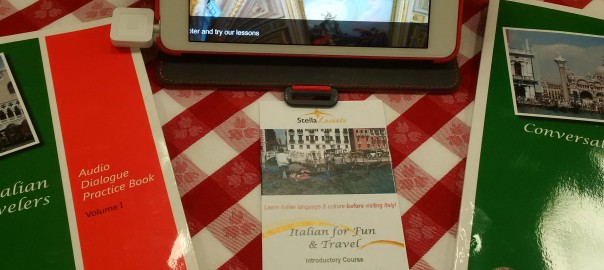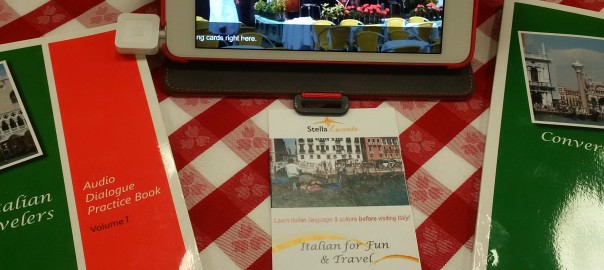Italian Subjunctive (Part 7): Italian Subjunctive Commands
Italian subjunctive commands: Learn when to use the Italian subjunctive mood to make Italian subjunctive commands!
Speak Italian: Italian Subjunctive Commands — Familiar and Polite Commands
Can you speak Italian? By now, many of you have passed the beginning stages of learning to speak Italian and can read and comprehend quite a bit of the Italian language. Meraviglioso!
But have you tried to take the next step to speak Italian fluently? Do you know which situations use the Italian subjunctive mood? To express complex feelings in Italian correctly, it is important to use the Italian subjunctive mood. Using the subjunctive mood is difficult for English speakers, as we only rarely use this tense in English, and this is something that I am always working on!
This is the final blog in the “Speak Italian” blog series that has focused on how to use the Italian subjunctive mood, or “il congiuntivo.”
Let’s take that giant step from simple beginning sentences to more complex and fluid sentences in Italian by using the subjunctive mood. In this segment, we will discuss the Italian imperative verb tense, or “command form” of a verb. Then we will describe how to make and use polite commands with the Italian subjunctive mood. A dependent clause in the subjunctive mood can be used with the familiar command form of a verb. We will also discuss how to use the Italian present tense subjunctive as an independent clause to give a polite command.
Speak Italian: How to Use the Italian Subjunctive Mood
In each blog in the “Speak Italian” series about the Italian subjunctive mood (“il congiuntivo”), we have been presenting situations take the Italian subjunctive mood.
In this blog, we will present when to use the Italian subjunctive mood in the present tense with familiar commands, as well as how to use the present tense subjunctive as an independent clause to give polite commands.
Remember these examples as “anchors” in your knowledge for when you must speak Italian and try out the subjunctive mood in your next Italian conversation!
Enjoy our blog: “Italian Subjunctive (Part 7): Italian Subjunctive Commands
—Kathryn Occhipinti
Some of this material is adapted from our textbook, Conversational Italian for Travelers © 2012 by Stella Lucente, LLC, found on www.learntravelitalian.com. Special thanks to Italian instructor Maria Vanessa Colapinto.
Speak Italian (Part 7): A brief note about and review of the Italian subjunctive mood
As noted in the last section, in this blog we will present
how to make Italian subjunctive commands.
This will be the last blog in our Italian subjunctive mood series!
Before starting this blog, please review the comments in the next section about how the Italian subjunctive mood is used in the Italian language. All the material we have covered so far about the Italian subjunctive mood is also listed for review at the end of this section, with links to our previous blogs.
*****************************
In previous blogs, we have noted that Italian uses a subjunctive mood that to express beliefs, thoughts, or hopes with the verbs credere, pensare, and sperare.
The subjunctive mood is also said to “open up” a conversation to discussion about a particular topic by expressing doubt, uncertainty, desire, or a feeling.
Certain phrases are commonly used to start a sentence in order to introduce the subjunctive mood, and these initial phrases can be in the indicative tense (the “usual” present or past tense) or in the conditional tense. These initial phrases imply uncertainty and trigger the subjunctive mood in the phrase to follow.
These groups are listed below.
Groups 1-9: “Noun Clauses”
Group 10: “Adverbial Clauses”
Groups 11 and 12: “Adjective/Pronoun Clauses”
-
-
- Phrases that use the verbs credere (to believe), pensare (to think), and sperare (to hope). These verbs use the pattern: [verb + di + infinitive verb] to describe the beliefs, thoughts, or hopes that one has. When the subject in the introductory phrase is not the same as the subject in the subjunctive clause that follows, the pattern changes to: [verb + che + subjunctive verb].*
- Impersonal constructions that begin with, “It is…” such as, “È possibile che…”
- Phrases that express a doubt, such as, “I don’t know…” or “Non so che…”
- Phrases that express suspicion, such as, ” I suspect that…” or “Sospetto che…”
- Phrases that express uncertainty, such as, “It seems to me…” or “Mi sembra che…” and ” To wonder if…” or “Chiedersi se… “
- Impersonal verbs followed by the conjunction che, such as, “Basta che…” “It is enough that,” or “Si dice che…” “They say that…
- Phrases that use the verbs volere, desiderare, chiedere, esigere when the subject in the introductory phrase is not the same as the subject in the clause that follows. In this situation, these verbs will be followed by che.
- Phrases that use the verbs piacere and dispiacere when the subject in the introductory phrase is not the same as the subject in the clause that follows. In this situation, these verbs will be followed by che.
- Phrases that express feelings (any emotion, fear, surprise) and use the pattern: [avere, essere, or augurarsi verb + di + infinitive verb]. When the subject in the introductory phrase is not the same as the subject in the clause that follows, the pattern changes to: [avere, essere, or augurarsi verb + che + subjunctive verb].
- Sentences that begin with words that end in –ché, or complex conjunctions that end with che: affinché, perché (so as, so that, in order that), purché (as long as, provided that, only if)**, a meno che, senza che (unless), può darsi che (it may be possible that, possibly, maybe), prima che (before that). Also the many words that mean although/even though, one of which ends in -che: benché (also sebenne, malgrado, nonostante).***
- Sentences that begin with adjectives or pronouns that include the idea of any in a description of a person, place or thing: qualsiasi, qualunque (any), chiunque (whoever), dovunque (anywhere).
- Sentences that begin with adjectives or pronouns that include the idea of nothing or only in a description of a person, place, or thing: niente che, nulla che (nothing that), nessuno che (nobody that), l’unico, il solo, a che (the only one that).
- Phrases that correspond to the English “both… and…” use the conjunction sia and the structure “sia… che…”
- Hypothetical Phrases: Phrases that begin with se (if) in certain situations. Phrases that begin with come se (as if), magari (if only), ammesso che (assuming that).
-
For a review of how to use the groups of phrases that need the Italian subjunctive mood listed above, please see our previous blogs on this topic by clicking on the links below:
How to Use the Present Tense Italian Subjunctive Mood (Parts 1-3).
How to Use the Imperfetto Subjunctive for Italian Past Tense (Parts 1-3)
How to Use The Italian Subjunctive Mood (Parts 4 and 5) — Hypothetical Phrases
************************************************
Points to remember about the subjunctive mood:
In Italian, the introductory phrases that take the subjunctive mood (those that trigger doubt, uncertainty, desire, or a feeling) usually end with a linking word, also known as a conjunction, which will be che. In this situation, che means that. The clause that follows our introductory phrase will then describe what the uncertainty is about.
We now see from Group 9 that some words or phrases already have -ché or che integrated into the word itself. In these cases, che is not repeated. The clause that follows our introductory phrase will then describe what the uncertainty is about.
*When the speaker in the introductory phrase will carry out the action in the phrase to follow, Italian will use the following construction to link the phrases for credere, pensare, and sperare : di + infinitive verb. Example: Penso di andare a Roma domani. = I think I will go to Rome tomorrow. (Use pensare a when thinking ABOUT something or someone.)
**solo se also means only if but does NOT take the subjunctive mode.
*** anche se also means even though/if but does NOT take the subjunctive mode.
************************************************
Finally, a word of caution:
DO NOT USE THE SUBJUNCTIVE WITH THE FOLLOWING THREE PHRASES!
Forse = Perhaps
Per me = For me
Secondo me = According to me
Solo se = Only if
Anche se = Even though, If
The above may seem like exceptions to the rule, but perhaps… because these phrases already express doubt or your personal opinion… in the Italian way of thinking, it would be redundant to use these phrases along with the subjunctive!
Speak Italian: Italian Subjunctive Familiar Commands
What is the Familiar Command Form of a Verb?
The imperative tense, or “command form” of a verb is used when one wants to relay an urgent request, give advice, or give an order.
In Italian, familiar commands — commands given by one person to another person or to a group of people that know each other — are realized by conjugating the commanding verb in the same way as for the present tense. (The exception is the singular present tense command -are verb form.) Otherwise, the verb endings will be the same as for the present tense. See how this works in more detail below.
******************************
How to Conjugate Verbs for the
Familiar Command Form
The table below shows the familiar imperative endings for the –are, -ere, and –ire verb groups. These endings are removed to create the stem, to which the endings in the table are added. In written Italian, an exclamation point is used to convey the idea that the verb is in the imperative form.
Note that with the imperative verb form, by definition, the speaker is always giving a command to someone else. This means that there is no first person, or io conjugation to learn.
The tu command form is used when one person is giving a command to a single individual. You will note from the red highlighted –a that only the –are verbs have an imperative ending that differs from the present tense. The -ere and -ire verb endings for the tu imperative from are identical to the present tense.
When speaking to a group of people we know, with the familiar you all, or voi form, the endings for the imperative present tense are also identical to the simple present tense!
There is an imperative noi form, which also has a single ending that is identical to the present tense. For the noi imperative form, the meaning of the verb changes to: “Let’s… ” Now, doesn’t it make sense that “Andiamo!” means, “Let’s go!”? We are simply using the imperative form of the present tense!
Familiar Imperative Tense Endings
| -are | -ere | -ire | |
| tu | a(!) | i(!) | i(!) |
| noi | iamo(!) | iamo(!) | iamo(!) |
| voi | ate(!) | ete(!) | ite(!) |
When creating a sentence with the familiar command form, the subject pronoun is usually left out, as is usual for Italian, although it can sometimes be added for emphasis. In most cases of spoken Italian, though, the sentence will consist of just the verb itself. See the examples below.
| Guardare
(to look) |
Rispondere
(to answer) |
Partire
(to leave) |
|
| tu | Guarda! Look! |
Rispondi! Answer! |
Parti! Leave! |
| noi | Guardiamo! Let’s look! |
Rispondiamo! Let’s answer! |
Partiamo! Let’s leave! |
| voi | Guardate! (You all) look! |
Rispondete! (You all) answer! |
Partite! (You all) leave! |
******************************
How to Conjugate Irregular Verbs for the
Familiar Command Form
There are many verbs that are irregular in the familiar command form, including the auxiliary verbs avere (to have) and essere (to be), and the irregular verb stare. Remember that stare, which originally meant “to stay,” often means “to be” in matters of health. The familiar imperative conjugations for the auxiliary verbs and additional commonly used verbs are given in the tables below.
Imperative Irregular Auxiliary Verbs and Stare
| Avere
(to have) |
Essere
(to be) |
Stare
(to stay/to be) |
|
| tu | abbi! | sii! | stà! |
| noi | abbiamo! | siamo! | stiamo! |
| voi | abbiate! | siate! | state! |
Common Imperative Irregular Verbs
| Andare
(to go) |
Dare
(to give) |
Dire
(to say/to tell) |
Fare
(to do/to make) |
|
| tu | vai!, và! | dai!, dà! | di! | fai!, fà! |
| noi | andiamo! | diamo! | diciamo! | facciamo! |
| voi | andate! | date! | dite! | fate! |
******************************
How to Make Negative Familiar Commands
When commanding someone you know not to do something — using the familiar tu form — it is very easy. Whether the verb is regular or reflexive, simply put the word non in front of the infinitive form of the verb. In other words, do not conjugate!
To make a negative command with a reflexive verb in the tu form, the “si” ending is dropped and the reflexive pronoun ti then needs to be tacked on to the end of the verb.
For all verbs, leave out the subject pronoun tu from the sentence. In our examples this subject pronoun will be given in parentheses as a reminder.
So, using preoccuparsi (to be worried) and guardare (to look) and parlare (to talk/speak) as examples:
(tu) Non preoccuparti! Don’t (you fam.) worry yourself!
(tu) Non guardare! Don’t (you fam.) look!
(tu) Non parlare! Don’t (you fam.) speak!
For the negative in the noi and voi forms, conjugate as usual and simply put non in front of the verb. Remember to add the reflexive pronoun to the ending of the verb if it is reflexive. Again, the subject pronouns are usually omitted, and so are given in parentheses.
(noi) Non preoccupiamoci! Let’s not worry (ourselves)!
(voi) Non preoccupatevi! (You all) Don’t worry yourselves!
(noi) Non guardiamo! Let’s not look!
(voi) Non guardate! (You all) Don’t look!
******************************
Where are Reflexive, Direct and Indirect Pronouns Placed in Sentences
with the Familiar Command Form?
For a review of how to use reflexive, direct, and indirect object pronouns, please consult Conversational Italian for Travelers “Just the Grammar” book. A summary table taken from this book is provided below to aid in the discussion of pronouns that follows.
Reflexive, Direct, and Indirect Object Pronouns
Reflexive Pronouns Direct Object Pronouns Indirect Object Pronouns mi myself mi me mi to me ti yourself(fam.) ti you (fam.) ti to you (fam.) si yourself (pol.) La (L’) you (pol.) Le to you (pol.) si herself la (l’) her, it (fem.) le to her si himself lo (l’) him, it (masc.) gli to him ci ourselves ci us ci to us vi yourselves vi you all vi to you all si themselves le them (fem.) gli to them (fem.) si themselves li them (masc.) gli to them (masc.)
Reflexive Pronouns:
When conjugating a reflexive verb into the familiar imperative form, it is not enough just to use the correct verb ending. We must also place the reflexive pronoun in the proper position with respect to the verb, which in this case is after the verb, and attached to the end of the conjugated form! This rule holds true for the tu, noi, and voi forms. The conjugated verb and attached pronoun are spoken as one word (see below).
This rule may seem confusing at first, since we have spent so much time thinking in Italian and putting the reflexive pronouns before the verb. Try to remember the correct way to conjugate the reflexive imperative verbs from everyday experiences.
For instance, when welcoming a friend into your home, you would say, “Accomodati!” for “Make yourself comfortable!”
Common phrases a mother might say to a teenager on a school morning would be, “Alzati!”or, “Wake (yourself) up!” and “Sbrigati!” for “ Hurry (yourself) up!”.
And, in Italian households, each person in the family is encouraged to “Siediti!” for “Sit (yourself) down!” so everyone can eat together before the food gets cold!
Two example tables have been provided. Notice the spelling change for our example verb sbrigarsi for the noi form in the table below. The spelling change is necessary to keep the sound of this form constant with the infinitive form and other conjugated forms.
Imperative Accomodarsi – to get comfortable
| tu | Accomodati! | Get (Make yourself) comfortable! |
| noi | Accomodiamoci! | Let’s get comfortable! |
| voi | Accomodatevi! | You all get comfortable! |
Imperative Sbrigarsi – to hurry (oneself) up
| tu | Sbrigati! | Hurry (yourself/familiar) up! |
| noi | Sbrighiamoci! | Let’s hurry (ourselves) up! |
| voi | Sbrigatevi! | Hurry (yourselves/familiar) up! |
Direct and Indirect Pronouns:
After conjugating a regular verb into the familiar imperative form, if we want to include a direct or indirect object pronoun in the sentence, these pronouns will come after the verb, and will be attached to the end of the conjugated form. This should be easy to remember, as the sentence structure is the same as for English.
This rule also applies when the Italian direct and indirect object pronouns are themselves combined to make one word.
The conjugated Italian verb and attached pronoun are spoken as one word.
See the examples with the familiar command forms for dare (to give) and fare (to do/to make): The “m” is doubled by convention in these constructions.
Dammi il pacco! Give me the package!
Dammelo! Give it to me!
Fammi un favore! Do me favor!
Fammelo! Do it for me!
*******************************
How to Use the Italian Subjunctive Mood:
Familiar Commands
When one person is giving a command to another about what someone else should do — in short, when the subject of the first phrase in the sentence is not the same as the subject in the second phrase — the second phrase verb will need to be in the subjunctive mood.
It should be noted here that the imperative form, or command form of a verb, is used not just to give a direct order, but also to make an urgent request or to give advice. So there are many instances when a command form may initiate a sentence. This command is then linked, as usual, with the conjunction che to the next phrase in the subjunctive mood.
Two examples follow, with our command form of dare, which is “di” and subjunctive verbs faccia and vediamo in green. Remember that the noi ending for the present tense (-iamo) serves as the present subjunctive ending as well.
(Tu) Di a Maria che lei non faccia tardi.
(You) Tell Maria that she should not be late.
(Tu) Digli che ci vediamo domani!
(You) Tell him we’ll see him tomorrow!
Speak Italian: Italian Subjunctive Polite Commands
What is the Polite Command Form of a Verb?
The imperative tense, or “command form” of a verb is used when one wants to relay an urgent request, give advice, or give an order.
In Italian, polite commands — commands given by one person to another or to a group of people that the speaker does not know well — are realized by conjugating the commanding verb in the present tense subjunctive mood. An exclamation point may be added after the command if desired.
******************************
How to Conjugate Verbs in the
Polite Command Form = Present Subjunctive
The table below shows the present tense subjunctive endings for the –are, -ere, and –ire verb groups. These endings are removed to create the stem, to which the endings in the table are added. In written Italian, an exclamation point is used to convey the idea that the verb is in the imperative form.
Note that with the imperative verb form, by definition, the speaker is always giving a command to someone else that he or she does not know well. This means that there is no first person, or io conjugation to learn.
The Lei, or polite you, present tense subjunctive form of the verb (presente congiuntivo) is used when one person is giving a command to a single individual that he or she does not know well.
The Loro, or polite you plural, present tense subjunctive form of the verb can be used when one person is giving a command to a group of people that he or she does not know well. This situation may occur in organizations, or in large gatherings, when a leader or speaker must address a group of people. We will not provide examples using the Loro, or polite you command form, as it is no longer in common use.
The table below gives the conjugation for the first three persons of the present subjunctive mood (presente congiuntivo), for the -are, -ere, and -ire groups of verbs. For a polite command, we need only to focus on the Lei form in the present subjunctive but notice that the endings are the same for all three persons for the three types of verbs.
Subjunctive Mood – Present Tense (Presente Congiuntivo)
| Subject Pronoun | -are ending | -ere ending | -ire ending |
| io | i | a | a |
| tu | i | a | a |
| Lei/lei/lui | i | a | a |
When creating a sentence with the polite command form, the subject pronoun is left out. Below are the subjunctive present tense conjugations for the example verbs we encountered in the earlier section. The tables to follow give the present tense subjunctive conjugations for the auxiliary verbs and the common irregular verbs we discussed in the last section.
| Guardare
(to look) |
Rispondere
(to answer) |
Partire
(to leave) |
|
| Lei | Guardi! Look! |
Risponda! Answer! |
Parta! Leave! |
Subjunctive Mood – Irregular Auxiliary Verbs and Stare for Polite Commands
| Avere
(to have) |
Essere
(to be) |
Stare
(to stay/be) |
|
| Lei | abbia! | sia! | stia! |
Subjunctive Mood – Irregular Verbs for Polite Commands
| Andare
(to go) |
Dare
(to give) |
Dire
(to say/to tell) |
Fare
(to do/to make) |
|
| Lei | Vada! | Dia! | Dica! | Faccia! |
******************************
Where are Reflexive, Direct and Indirect Pronouns Placed in Sentences
with the Polite Command Form?
For a review of how to use reflexive, direct, and indirect object pronouns, please consult Conversational Italian for Travelers “Just the Grammar” book. A summary table taken from this book was provided in the last section to aid in the discussion of pronouns that follows.
Reflexive Pronouns:
When conjugating a reflexive verb into the polite imperative form, it is not enough just to use the correct present subjunctive verb ending. We must also place the reflexive pronoun in the proper position with respect to the verb, which in this case is before the verb.
Below is a summary table that shows the differences between the familiar and polite command forms of the reflexive verb accomodarsi that we used as our example in the first section. This is one verb that is heard quite often in both its familiar and polite forms and well-worth committing to memory.
Imperative Accomodarsi – to get comfortable
| tu | Accomodati! | Get (Make yourself) comfortable! |
| Lei | Si Accomodi! | Get (Make yourself) comfortable! |
Direct and Indirect Pronouns:
After conjugating a regular verb into the polite imperative form with the correct subjunctive ending, if we want to include a direct or indirect object pronoun in the sentence, these pronouns will come before the verb.
This rule also applies when the Italian direct and indirect object pronouns are themselves combined to make one word, which will be pronounced separately.
Below are the examples provided in the section on familiar command forms for dare (to give) and fare (to do/to make). The polite command form has been added to each.
Familiar: Dammi il pacco! Give me the package!
Polite: Mi dia il pacco!
Familiar: Dammelo! Give it to me!
Polite: Me lo dia!
Familiar: Fammi un favore! Do me a favor!
Polite: Mi faccia un favore!
Familiar: Fammelo! Do it for me!
Polite: Me lo faccia!
Familiar: Digli che ci vediamo domani! Tell him that we’ll see him tomorrow!
Polite: Gli dica che ci vediamo domani!
Kathryn Occhipinti, MD, is the author of the
Conversational Italian for Travelers series of books and a teacher of Italian for travelers to Italy in the Peoria and Chicago area.
“Everything you need to know to enjoy your visit to Italy!”
Join my Conversational Italian! Facebook group and follow me on Twitter at StellaLucente@travelitalian1 and start to learn Italian today for FREE!
Conversational Italian! Facebook Group
Tweet @travelitalian1 for Stella Lucente Italian
YouTube videos to learn Italian are available from © Stella Lucente, LLC.
Learn Conversational Italian.
More information on and photographs of Italy can be found on Facebook Stella Lucente Italian and Pinterest Stella Lucente Italian.
Facebook Stella Lucente Italian
Pinterest Stella Lucente Italian
Visit learntravelitalian.com/download.html to purchase/download Conversational Italian for Travelers and find more interesting facts and helpful hints about getting around Italy! Learn how to buy train tickets online, how to make international and local telephone calls, and how to decipher Italian coffee names and restaurant menus, all while gaining the basic understanding of Italian that you will need to know to communicate easily and effectively while in Italy. —From the staff at Stella Lucente, LLC
Italian Subjunctive (Part 7): Italian Subjunctive Commands









